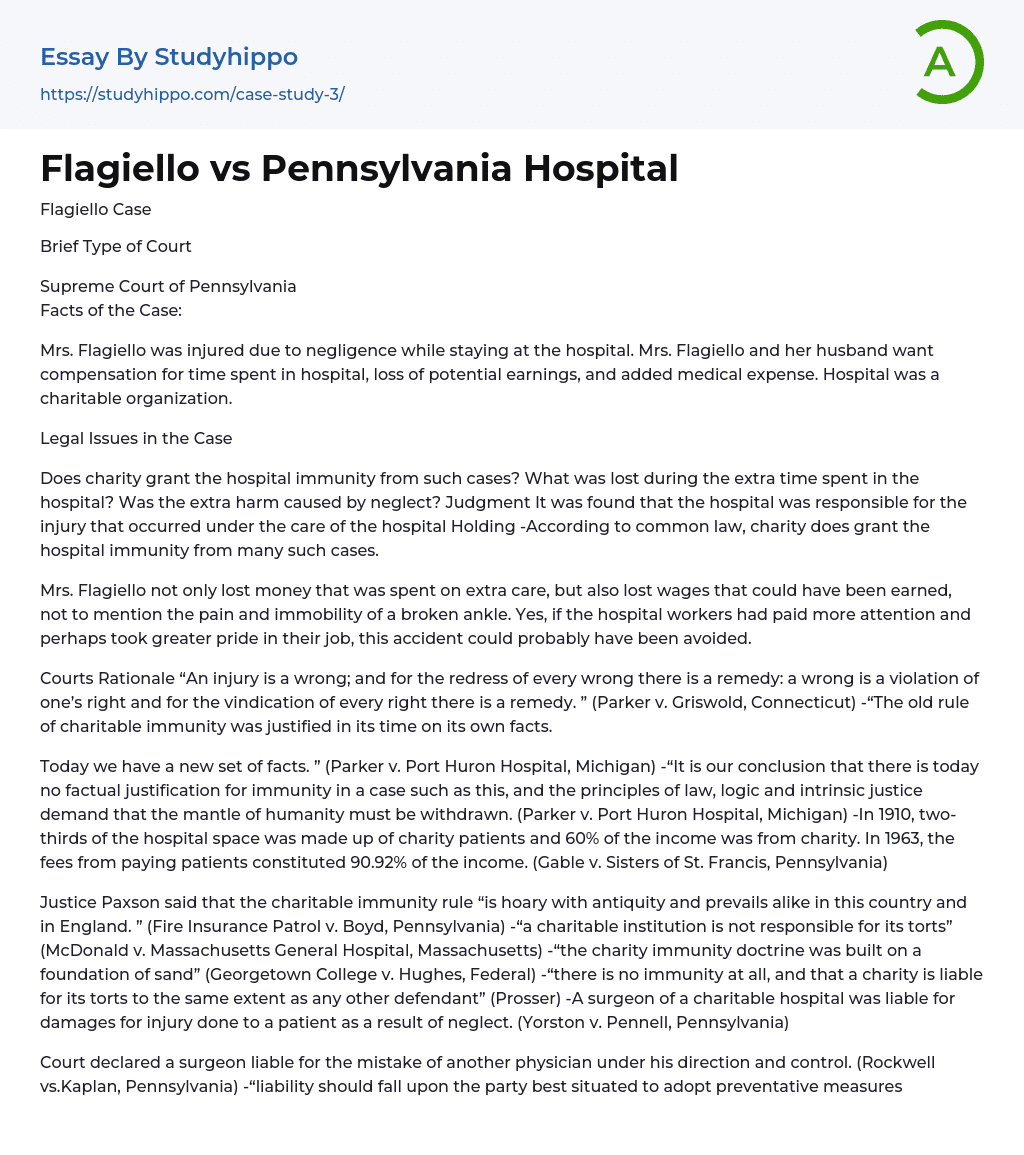Flagiello Case
Brief Type of Court
Supreme Court of Pennsylvania
Facts of the Case:
Mrs. Flagiello was injured due to negligence while staying at the hospital. Mrs. Flagiello and her husband want compensation for time spent in hospital, loss of potential earnings, and added medical expense. Hospital was a charitable organization.
Legal Issues in the Case
Does charity grant the hospital immunity from such cases? What was lost during the extra time spent in the hospital? Was the extra harm caused by neglect? Judgment It was found that the hospital was responsible for the injury that occurred under the care of the hospital Holding -According to common law, charity does grant the hospital immunity from many such cases.
Mrs. Flagiello not only lost money that was spent on extra car
...e, but also lost wages that could have been earned, not to mention the pain and immobility of a broken ankle. Yes, if the hospital workers had paid more attention and perhaps took greater pride in their job, this accident could probably have been avoided.
Courts Rationale “An injury is a wrong; and for the redress of every wrong there is a remedy: a wrong is a violation of one’s right and for the vindication of every right there is a remedy. ” (Parker v. Griswold, Connecticut) -“The old rule of charitable immunity was justified in its time on its own facts.
Today we have a new set of facts. ” (Parker v. Port Huron Hospital, Michigan) -“It is our conclusion that there is today no factual justification for immunity in a case such as this, and the principles of law, logic and intrinsic justice demand that the mantle of humanity must be withdrawn. (Parker
v. Port Huron Hospital, Michigan) -In 1910, two-thirds of the hospital space was made up of charity patients and 60% of the income was from charity. In 1963, the fees from paying patients constituted 90.92% of the income. (Gable v. Sisters of St. Francis, Pennsylvania)
Justice Paxson said that the charitable immunity rule “is hoary with antiquity and prevails alike in this country and in England. ” (Fire Insurance Patrol v. Boyd, Pennsylvania) -“a charitable institution is not responsible for its torts” (McDonald v. Massachusetts General Hospital, Massachusetts) -“the charity immunity doctrine was built on a foundation of sand” (Georgetown College v. Hughes, Federal) -“there is no immunity at all, and that a charity is liable for its torts to the same extent as any other defendant” (Prosser) -A surgeon of a charitable hospital was liable for damages for injury done to a patient as a result of neglect. (Yorston v. Pennell, Pennsylvania)
Court declared a surgeon liable for the mistake of another physician under his direction and control. (Rockwell vs.Kaplan, Pennsylvania) -“liability should fall upon the party best situated to adopt preventative measures and thereby to reduce the likelihood of injury” (Italia Societa per Azioni di Navagazione v. Oregon Stevedoring Co. , United States) -“No statistical evidence has been presented to show that the mortality or crippling of charities has been greater in states which impose full or partial liability than where complete or substantially full immunity is given. (Judge Rutledge) (Georgetown v. Hughes, Federal). When a court decides to change a rule, it says that the reason for the rule no longer exists.The reason for immunity never did exist.
“To be sure, it is never too
late for this court to correct a misconception” (Green v. United States, U. S. ) -“the rule should remain heretofore short of legislative change” (Bond v. Pittsburgh, supra)
Was Common Law Changed?
Common law was changed. It was changed by a majority vote in the court. Ethics Affecting this Case -Ethics affect this case with the question of whether a charity should be liable for injury caused by neglect. In this case Mrs. Flagiello is injured due to the neglect of two employees of a charity hospital. Ethics are involved because whether the hospital is a charitable organization or not, it is an organization built around the care of others. The hospital should always try its best to help the patient in any way it can. If the patient is injured due to the fault of the hospital, the hospital, if it truly is a charitable and therefore good and moral establishment, would want to recognize its mistake and solve the incident in the most ethical way.
- Anatomy and Physiology essays
- Addiction essays
- Biodegradation essays
- Dental Care essays
- Disease essays
- Disorders essays
- Health Care essays
- Intelligence Quotient essays
- Nutrition essays
- Olfaction essays
- Public Health essays
- Women's Health essays
- World health organization essays
- Cancer essays
- Infectious Disease essays
- Lung Cancer essays
- Neurology essays
- Physical Exercise essays
- Medicine essays
- Sex essays
- Inquiry essays
- Disability essays
- Poison essays
- Action Potential essays
- Nervous System essays
- Childbirth essays
- Puberty essays
- Blood essays
- Kidney essays
- Neuron essays
- Body essays
- Glucose essays
- Sense essays
- Heart essays
- Skeleton essays
- Human Physiology essays
- Eye essays
- Immune System essays
- Muscle essays
- Skin essays
- Brain essays
- Central Nervous System essays
- Human Skin Color essays
- Digestive System essays
- Common sense essays
- Respiration essays
- alcoholism essays
- Smoking essays
- Casino essays
- Tobacco essays




